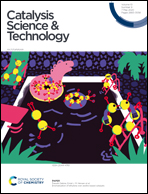Superior adsorption capability and excellent photocatalytic activity derived from the ferroelectric external screening effect in Bi3TiNbO9 single-crystal nanosheets†
Abstract
The efficient adsorption of molecules on functional material surfaces plays a crucial role in promoting their performances in various applications. In contrast with the common route to improve molecule adsorption by simply increasing the specific surface area, a new and more effective strategy to enhance adsorption on ferroelectric Bi3TiNbO9 based on the ferroelectric external screening effect was explored in this work. Single-crystal nanosheets were synthesized by the molten salt method (BTNO-M). Benefitting from the ferroelectric external screening effect, the specific-surface-area-normalized adsorption amounts of rhodamine B (cationic dye) and methyl orange (anionic dye) on BTNO-M were 22.3 and 10.7 times higher than those on P25, respectively. The enhanced adsorption induced by the ferroelectric external screening effect was further demonstrated by corona-poling experiments. Correspondingly, the direct photoexcitation degradation rates of rhodamine B and methyl orange (λ = 254 nm) by BTNO-M were 6.91 and 7.54 times those for P25. More importantly, the indirect photosensitization degradation rate of rhodamine B (λ > 420 nm) by BTNO-M was 13.6 times as high as that for P25, demonstrating that efficient adsorption greatly accelerated the photocatalytic process. This new strategy may also have potential applications in dye-sensitized solar cells, photoelectrochemical cells, chemosensors or biosensors.



 Please wait while we load your content...
Please wait while we load your content...